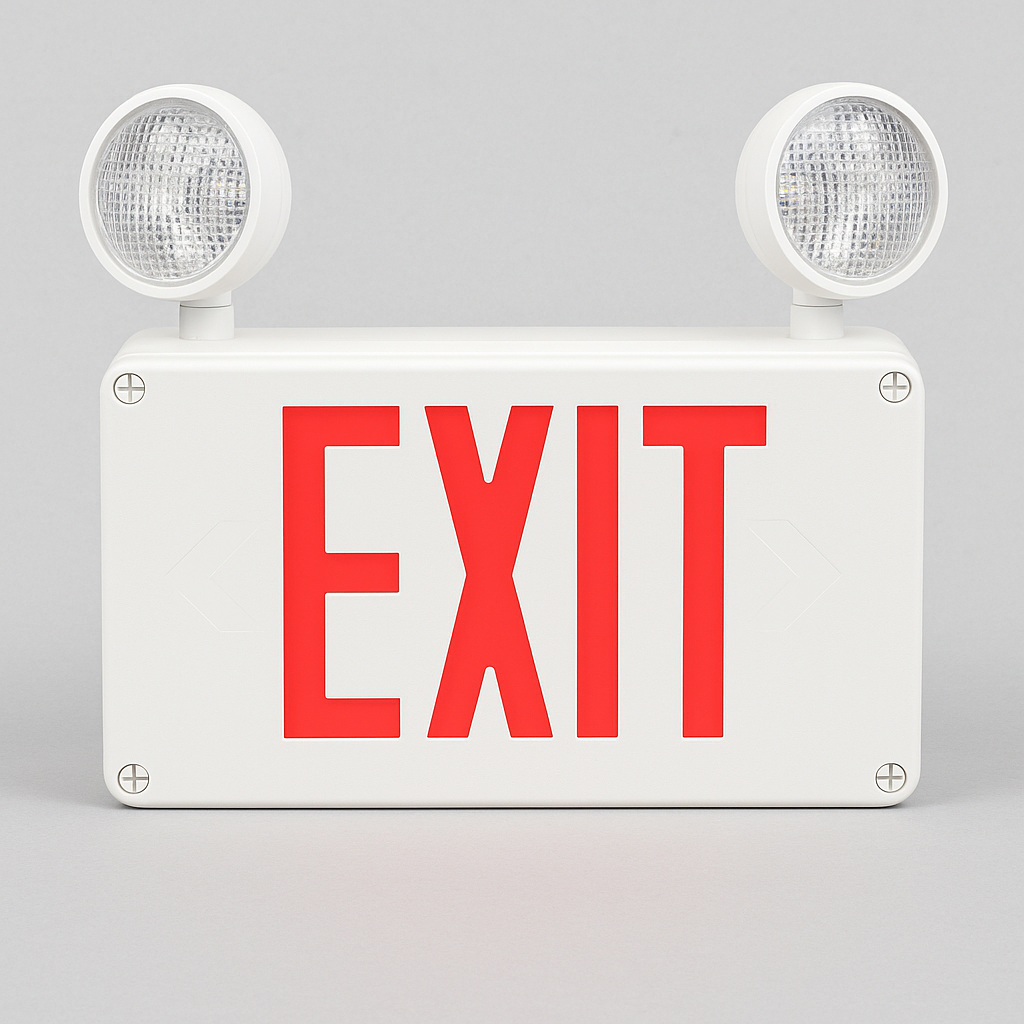Commercial building managers often ask which exit sign rating they need when moisture is involved. This guide explains exactly when to choose a wet location model versus a damp location model, how IP and NEMA ratings work, and why true wet-location units have fully sealed enclosures.
Last updated: August 2025
Quick Picks (TL;DR)

For Outdoor or Direct Water Exposure
Wet location exit signs are fully sealed and NEMA 4X/IP66 rated, ideal for exterior doors, open garages, and wash-down areas.

For Humid but Sheltered Areas
Damp location exit signs handle humidity and light splashes, perfect for locker rooms, indoor pools, or covered walkways.

For Signage + Emergency Lighting
Wet location exit sign combos combine an IP66-rated sign with integrated emergency light heads.
Table of Contents
Core Differences Between Wet and Damp Location Ratings
The key difference is simple: wet location exit signs are designed for direct contact with water, while damp location exit signs are intended for environments with moisture or humidity but no direct water spray.
- Wet location signs: Withstand rain, hose-directed water, snow, sleet, and wash-down cleaning.
- Damp location signs: Handle high humidity, light splashes, and condensation but not direct spray.
Understanding UL Location Ratings
UL (Underwriters Laboratories) testing certifies products for their intended environments. All exit signs should be UL 924 listed to meet emergency lighting performance standards, but their environmental rating — damp or wet — is what determines where they can be installed.
- UL Damp Location: Safe in humid environments and light moisture, no direct spray.
- UL Wet Location: Safe in environments where water can contact the enclosure directly.
Always check both the UL 924 marking and the location rating on the spec sheet before installing.
IP Ratings Explained
Ingress Protection (IP) ratings use two digits to define resistance to dust and water. The first digit indicates dust protection; the second, water protection.
- First digit (0–6): Dust protection level; “6” means dust-tight.
- Second digit (0–9): Water protection level; “5” = water jets, “6” = powerful jets.
Most wet location exit signs are rated IP65 or IP66, meaning they are fully dust-tight and protected against water jets from any direction.
NEMA Standards and What They Mean
NEMA (National Electrical Manufacturers Association) enclosure ratings are another way to classify environmental protection, especially common in North America:
- NEMA 3R: Rainproof, suitable for outdoor use but not sealed against hose spray.
- NEMA 4: Watertight and dust-tight, handles hose-directed water.
- NEMA 4X: Same as NEMA 4 but with added corrosion resistance — ideal for coastal or industrial environments.
For true wet-location use, choose at least NEMA 4, and NEMA 4X if corrosion resistance is important.
Why True Wet Location Models Have Fully Sealed Enclosures
Wet-location exit signs are built like waterproof vaults. Their housings are typically made of polycarbonate, fiberglass, or die-cast aluminum, with gaskets sealing every opening to prevent water ingress.
- Gasketed lenses and housing seams to block water.
- Waterproof conduit entries to protect wiring connections.
- Corrosion-resistant materials for harsh environments.
By contrast, damp-location signs use moisture-resistant materials but may have small ventilation gaps, as they’re not designed for direct water contact.
Common Applications for Each Rating
Damp Location Examples
- Indoor swimming pools
- Locker rooms and restrooms
- Covered outdoor corridors or vestibules
Wet Location Examples
- Exterior building exits
- Outdoor stairwells
- Open-air parking garages
- Food processing or wash-down areas
Side-by-Side Comparison
| Feature | Damp Location | Wet Location |
|---|---|---|
| Water Exposure | Humidity, condensation, light splashes | Direct rain, hose spray, snow |
| IP Rating | Not usually specified | IP65/IP66 |
| NEMA | 1 or 2 | 3R, 4, or 4X |
| Housing | Moisture-resistant | Fully gasketed, sealed |
| Cost | Lower | Higher (more robust construction) |
Maintenance, Installation, and Compliance
Keeping your exit signs functional is both a code requirement and a safety necessity. NFPA 101 and OSHA regulations require that emergency lighting, including exit signs, be tested regularly and maintained in good working order.
Key Maintenance Tasks
- Monthly: Quick push-button test to ensure battery backup works.
- Annually: 90-minute discharge test under battery power.
- Every 4–5 years: Replace batteries proactively to prevent failures.
Installation Best Practices
- Use waterproof conduit fittings for wet-location installations.
- Ensure gaskets are seated properly during assembly.
- Verify local code compliance, especially for letter height and color.
Product Recommendations
Further Reading from Our Blog
Conclusion
Choosing the right exit sign rating is about matching the product to the environment. Damp-location models are perfect for humid but protected spaces. Wet-location models are essential for any location with direct water exposure. Making the correct choice ensures compliance, longevity, and above all, safety for building occupants.



